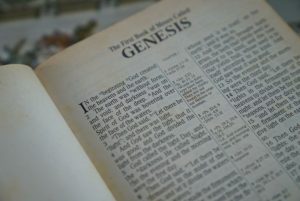Everyone struggles in this life at one time or another, don’t you agree? Why is it that we all seem to have an innate feeling that things are not the way they are suppose to be? We don’t want to have unrest in our families, we don’t plan to hurt others with our words or actions, and none of us ever want to deal with the death of a loved one, but it happens to all of us. Why?
From all my years of searching I have found that the Christian worldview is the only view that provides answers to the “why” and a solution that gives hope for the future. The evidence is in God’s Word, the Bible, and in a person named Jesus. To really understand the Christian worldview (and not the one portrayed in popular culture) we have to know the whole story, from the beginning to the end. In other words, we need to commit some time to reading and we need to understand the big picture before delving into a serious study of the Bible.
If you have doubts about the reliability of the Bible go back to the last series we did called “A Case for the Bible 101” before starting this study. That series should answer questions you might have about the authenticity, historicity, and inerrancy of the Bible. Trusting who God is, and His ability to communicate with us is important. Pray sincerely, as I once did, that the truth about God and His will for our lives can been known. I believe the Holy Spirit will open it up to you, as He did for me.
People often begin reading the Bible without knowing the “big picture” it’s like picking up and reading a novel without knowing anything about the author and the storyline
It is important to remember that the Christian Bible is made up of 66 individual books, written by at least 40 authors, over a period of about 1500 years, yet it has a cohesive and seamless storyline:
The Bible’s main character: God
The conflict in the story: Sin and Rulership
The main theme: Rescue and Redemption
Overarching Message of the Bible: THE UNFOLDING OF GOD’S RESCUE PLAN OF SALVATION – THE SCARLET THREAD OF JESUS!
The Christian Bible gives us a linear storyline that we can follow from beginning to end
God’s story looks like this:
1. The curtain opens in Genesis: God creates a perfect world and humans have a perfect relationship with Him and all of the creation
2. The conflict occurs in Genesis 3: Humans rebel against God, influenced by Satan
Note: God created us with freewill (choice to love/or not love), and our original parents chose to go against God (sin), changing everything. Death (physical and spiritual) was the result of this “Fall” from God, and humankind needed rescuing, which God “Promised” would come.
3. The Old Testament continues as the unfolding of God’s rescue plan of salvation is given to a particular man (Abraham), and carried through a particular nation (Israel), with every subsequent person, story, and event pointing to that ultimate fulfillment in Jesus
4. The New Testament fulfills the rescue plan through Jesus by His sacrifice on the cross and Resurrection in defeat of death (both physical and spiritual) – this redemption is offered to everyone by way of the the Holy Spirit
5. The curtain closes in Revelation: Here we find the conclusion to the story with the permanent defeat of Satan and death as the final acts of Jesus are fulfilled
The Apostle John tells us, in this last book of the New Testament, about a future time when the things of this world will be no more:
Then I saw a new heaven and a new earth, for the old heaven and the old earth had disappeared. And the sea was also gone. And I saw the holy city, the new Jerusalem, coming down from God out of heaven like a bride beautifully dressed for her husband. I heard a loud shout from the throne, saying, “Look, God’s home is now among his people! He will live with them, and they will be his people. God himself will be with them. He will wipe every tear from their eyes, and there will be no more death or sorrow or crying or pain. All these things are gone forever.” And the one sitting on the throne said, “Look, I am making everything new!” And then he said to me, “Write this down, for what I tell you is trustworthy and true.” And he also said, “It is finished! I am the Alpha and the Omega—the Beginning and the End. To all who are thirsty I will give freely from the springs of the water of life. All who are victorious will inherit all these blessings, and I will be their God, and they will be my children. “But cowards, unbelievers, the corrupt, murderers, the immoral, those who practice witchcraft, idol worshipers, and all liars—their fate is in the fiery lake of burning sulfur. This is the second death.” Revelation 21:1-8 (NLT)
I don’t know about you, but I would like to be in that first group, the ones who are thirsty. How do I become one of those people? This same Apostle John is the one who wrote the Gospel of John. In that Gospel (and the other three as well) we are told about Jesus, His life, ministry, death and resurrection. We are told that all we need to do is believe in Him (John 3:16) and He will prepare a place for us in His eternal home (John 14). He is the one who has done all the work for us, we don’t need to do anything except believe in Him and then live our lives getting to know Him. He is not going to let us in His house if He doesn’t know us! (Matthew 7:23)
The best way to get to know Him is to read about Him in the Bible. Jesus is the scarlet thread all the way through. To give you a little more overview before you begin reading the book of Genesis here are a few things to consider:
- Learn the timeline, historical settings, events, people, and places as you read each book that make up the Christian Bible (a good study Bible will help you with this, I always recommend the Life Application Study Bible in NASB, NIV, or NLT)
- Learn the authors, audience, and purpose for the writings of each of the books (usually in the introduction of each book in a study Bible)
- Read with the understanding that the entire Bible points to the person of Jesus and that all the stories foreshadow something about Him in the case of the Old Testament; and the New Testament is about His life, ministry, sacrifice and resurrection on our behalf including the place He has prepared for our eternal home; it also teaches us how to be like Him as we share and do life with others
Here is a quick overview to get the “Big Picture” for both the Old and New Testaments (you can’t understand one without the other):
Old Testament:
- God creates us to be in relationship with Him (Genesis 1-2)
- Humans lose that relationship at “the Fall” when they disobey God’s only command (Genesis 3)
- God immediately “Promises” a way of salvation (a rescue plan) and begins to work that plan out in “Covenants” throughout the Old Testament—giving encouragement, warning, and hope through the prophets (Genesis 3:15; Genesis 12:2-3; Genesis 15:5-19; Genesis 26:3-5; Genesis 28:10-15; Genesis 49:9-12; Exodus 12-15; 19-20; 2 Samuel 7:5-17; Jeremiah 31:31)
- Every book (39), story, and event contains a foreshadow, model, or prophecy of Jesus (who He would be and what He would do)—the Scarlet Thread of the Old Testament – And the stories are exciting!
- The Old Testament gives the history of the Nation of Israel who was chosen to be God’s people and role-model to the other nations (but they failed all the time), showing the need for a Rescuer/Savior, and it would be through this Nation that Messiah would come
New Testament:
- Jesus is born, the promised Messiah from the tribe of Judah and line of David (Luke 3:23-37)
- Jesus is the New Covenant in fulfillment of God’s Old Covenant and the hundreds of prophecies made about Him centuries before (Luke 22:20; 2 Corinthians 3:6; Hebrews 8:7-13; 9:1-15)
- Jesus’ ministry proves that He is God incarnate evidenced by His sinless life and multitude of miracles attesting to His power over the natural order and His love for humanity
- Jesus dies as a substitute for all humanity, then resurrects from the grave in defeat of death and Satan, restoring that lost relationship with humankind and providing a path for eternal life (John 3:11-21)
- Jesus’ followers begin to spread this good news at Jesus’ command and giving of the Holy Spirit to all believers (Matthew 28:18-20; Acts 1:7-8)
- The early Church begins as disciples gathering in various places to worship and study Scripture (book of Acts)
- Jesus promises to come back bringing the full Kingdom of God creating a New Earth and New Heaven with no more pain, suffering, or death (Revelation 21:1-7)
- Our job, or purpose, until then is to share this good news with as many people as we can, living lives as God’s Ambassadors for the Kingdom, preparing for eternity (2 Corinthians 5:20)
The Beginning & the End:
The beginning of the Bible and the end of the Bible have a lot in common: They both show us God’s love and original intention for all of His creation!
In Genesis, the creation of heaven and earth are described
In Revelation, the new heaven and earth are described
In Genesis, God says, “Let there be light”
In Revelation, Jesus is the light of the new heaven and earth
In Genesis, sin is born
In Revelation, sin is destroyed
In Genesis, Satan makes his entrance
In Revelation, Satan makes his exit
In Genesis, death comes to humankind
In Revelation, death dies
In Genesis, We had a face-to-face friendship with God in the Garden of Eden
In Revelation, God restores that face to face friendship in the ‘new garden”
Going Deeper:
Watch Greg Koukl’s presentation of “The Story of Reality” to help with the understanding of the Bible’s big picture:
Genesis: Practicing The Hermeneutics
Before beginning the study in Genesis answer the following questions to the best of your ability. A good study Bible (my pick: the Life Application Study Bible in NASB, NIV, or NLT) will help you, and a little book called “The Essential Bible Companion” by John H. Walton and Mark L. Strauss.
- What do you already know about the book Genesis?
- Who was the author and what do we know about him? What other books did he write?
- Who was the audience and what do we know about them? What was going on at the time (of the audience)?
- What is the genre’ (Literary style) of this book? When was this book written?
- What is the purpose for the writing of this book?
- What are some of the main themes found in the book of Genesis:
- Why do you think it is important to understand the historical context in which the books of the Bible are written? What are some ways that we can do this? (share tools)
- Why is it important to understand the difference between interpretation and application when studying the Bible?
Join us next week as we begin to look at Genesis chapter one in making our case for “Creation!”
————————————————————————————————————————————————————
You will not find this material in the public school curriculum even though it is based on solid evidence and grounded in research. It is ironic that following the evidence to where it leads stops at the door of our public schools as they will not let a “Divine footprint” in! Join us as we examine evidence for Christianity and learn how to become a thoughtful defender and ambassador of your faith.
Click into the resource page of this website to view many of the top Christian thinkers and apologists along with some of their work; connecting to these types of resources is essential in your Christian growth.
Please let me know what you think: Give feedback, ask questions or send concerns in the comment section of the blog.
Teri Dugan
TeriDugan@truthfaithandreason.com
1 Peter 3:15





Sorry, comments are closed for this post.